Thermal spin-torque heat-assisted magnetic recording
IF 8.3
1区 材料科学
Q1 MATERIALS SCIENCE, MULTIDISCIPLINARY
引用次数: 0
Abstract
To achieve higher recording density with lower power consumption than the current heat-assisted magnetic recording (HAMR) for next-generation, a more efficient writing with less laser power would be indispensable. An advanced HAMR concept is developed to address such specification, and the write ability has been demonstrated in multilayer media stacks comprising the core structures of antiferromagnetic MnPt and ferromagnetic FePt layers with the magnetic easy axis oriented perpendicular to the film plane. The concept is based on two distinct switching mechanisms: thermally activated (TA) and spin-transfer-torque (STT) assisted magnetization switching. The latter is driven by an out-of-plane temperature gradient (ΔT) in the MnPt/FePt multilayer which is referred as thermal spin-torque (TST) HAMR media. Pump-probe measurements reveal significant magnetic coercivity (Hc) modulation by ΔT at the local magnetization of the FePt layer. The hybrid mechanism with TA and STT can be separated by sweeping the delay time between the pump and probe laser pulses, and it is found that the STT dominates the mechanism for Hc modulation in the short delay time regime. Furthermore, the modulation of Hc of the FePt layer is demonstrated to be dependent on the magnitude and the direction of steady state ΔT. These results suggest that lower laser power consumption is achievable owing to the contribution of STT assisted switching in the TST-HAMR media.


热自旋-扭矩热辅助磁记录
为了实现比当前热辅助磁记录(HAMR)更高的记录密度和更低的功耗,需要更低的激光功率和更高效的写入。为了解决这一问题,研究人员开发了一种先进的HAMR概念,并在由反铁磁性MnPt和铁磁性FePt层的核心结构组成的多层介质堆栈中证明了其写入能力,磁性易轴垂直于薄膜平面。该概念基于两种不同的开关机制:热激活(TA)和自旋传递扭矩(STT)辅助磁化开关。后者是由MnPt/FePt多层中的面外温度梯度(ΔT)驱动的,称为热自旋扭矩(TST) HAMR介质。泵-探针测量结果显示,在FePt层的局部磁化下,通过ΔT有显著的磁矫顽力(Hc)调制。通过扫描泵浦和探测激光脉冲之间的延迟时间,可以分离出TA和STT的混合机制,发现在短延迟时间范围内,STT在Hc调制机制中占主导地位。此外,证明了FePt层的Hc的调制依赖于稳态的大小和方向ΔT。这些结果表明,由于STT辅助开关在st - hamr介质中的贡献,可以实现更低的激光功耗。
本文章由计算机程序翻译,如有差异,请以英文原文为准。
求助全文
约1分钟内获得全文
求助全文
来源期刊

Acta Materialia
工程技术-材料科学:综合
CiteScore
16.10
自引率
8.50%
发文量
801
审稿时长
53 days
期刊介绍:
Acta Materialia serves as a platform for publishing full-length, original papers and commissioned overviews that contribute to a profound understanding of the correlation between the processing, structure, and properties of inorganic materials. The journal seeks papers with high impact potential or those that significantly propel the field forward. The scope includes the atomic and molecular arrangements, chemical and electronic structures, and microstructure of materials, focusing on their mechanical or functional behavior across all length scales, including nanostructures.
 求助内容:
求助内容: 应助结果提醒方式:
应助结果提醒方式:


